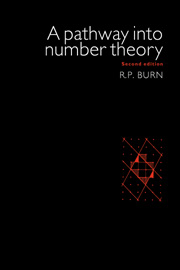Book contents
- Frontmatter
- Contents
- Preface to the second edition
- Introduction
- 1 The fundamental theorem of arithmetic
- 2 Modular addition and Euler's ɸ function
- 3 Modular multiplication
- 4 Quadratic residues
- 5 The equation xn + yn = zn, for n = 2, 3, 4
- 6 Sums of squares
- 7 Partitions
- 8 Quadratic forms
- 9 Geometry of numbers
- 10 Continued fractions
- 11 Approximation of irrationals by rationals
- Bibliography
- Index
- Frontmatter
- Contents
- Preface to the second edition
- Introduction
- 1 The fundamental theorem of arithmetic
- 2 Modular addition and Euler's ɸ function
- 3 Modular multiplication
- 4 Quadratic residues
- 5 The equation xn + yn = zn, for n = 2, 3, 4
- 6 Sums of squares
- 7 Partitions
- 8 Quadratic forms
- 9 Geometry of numbers
- 10 Continued fractions
- 11 Approximation of irrationals by rationals
- Bibliography
- Index
Summary
Fermat's theorem
1 6 ≡ 14 (mod 4) and 3 ≡ -1 (mod 4). Is it true that 6 • 3 ≡14(-1) (mod 4)?
If a ≡ b (mod 4) and c ≡ d (mod 4), can you prove that ac ≡ bd (mod 4)?
2 Make a multiplication table modulo 4 for the complete set of residues ﹛-4, 5,2, -1﹜. Does it have the same structure as the table you found for q 1.14?
3 If a ≡ b (mod n) and c ≡ d (mod n), use the equality ac-bd≡ (a-b)c + b(c-d) to prove that ac ≡ bd (mod n).
4 If a1, …, an is a complete set of residues modulo n, and the product modulo n of ai and aj is defined to be ak where aiaj (mod n), is ak uniquely defined?
Is there an element az such that a-za≡az for all i?
Is there an element aI such that aIai ≡ ai for all i?
5 If a1 …, an is a complete set of residues modulo n, and bu • • •, bn is a complete set of residues modulo n, how would you establish that the tables of products modulo n obtained from these two sets have the same structure? Your answer establishes a well-defined table for (Zn, x).
6 Examine the tables for multiplication modulo 3, 4, …, 16 given in table 3.1. Is there an identity in (Zn, x), for every n?
7 Compare the second row of the tables for (Z3, x), (Z4, x), …, (Z1o, x) with your answers to q 2.28. What is the similarity?
8 Compare the third row of the tables for (Z3, x), …, (Z10, x) with your answers to q 2.29. What is the similarity?
9 Compare the fourth row of the tables for (Z3, x), …, (Z10, x) with your answers to q 2.30. What is the similarity?
Information
- Type
- Chapter
- Information
- A Pathway Into Number Theory , pp. 48 - 78Publisher: Cambridge University PressPrint publication year: 1996
